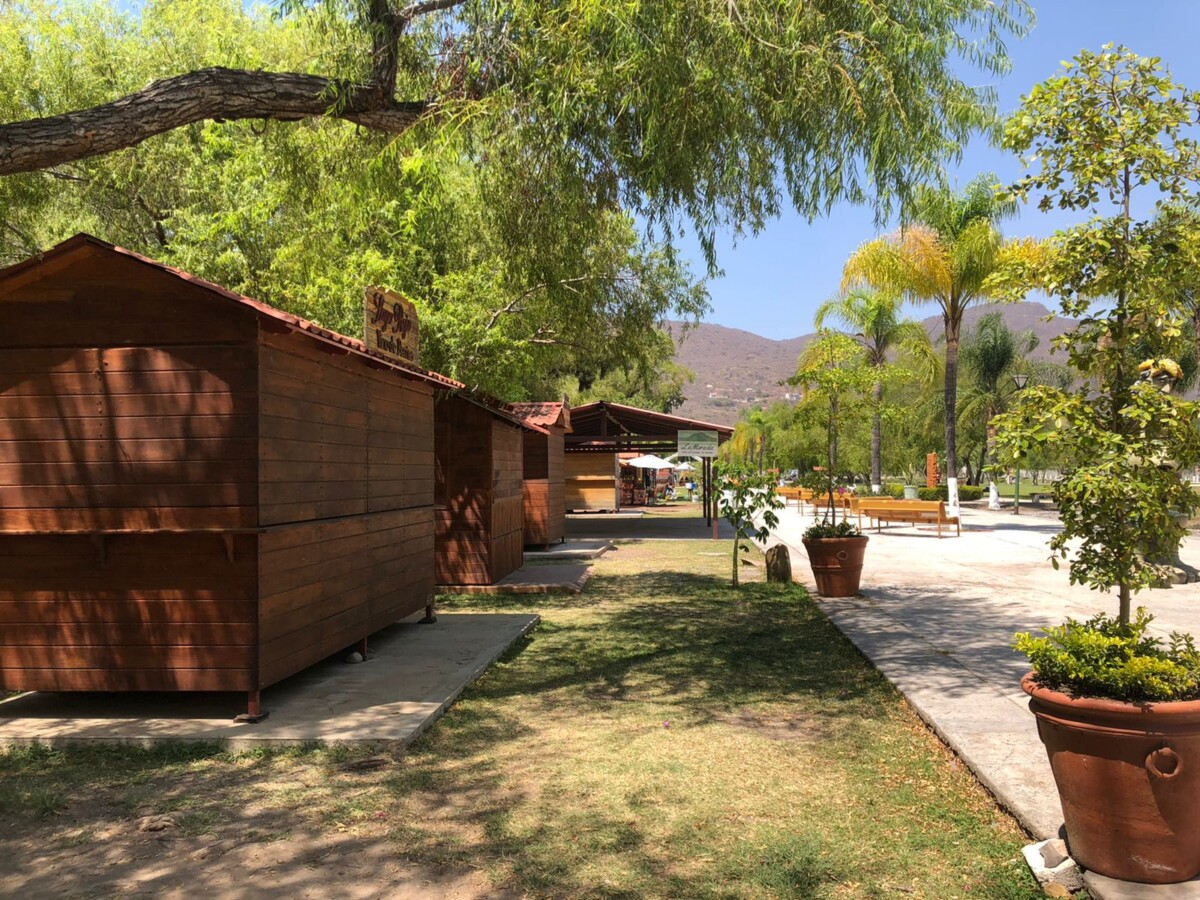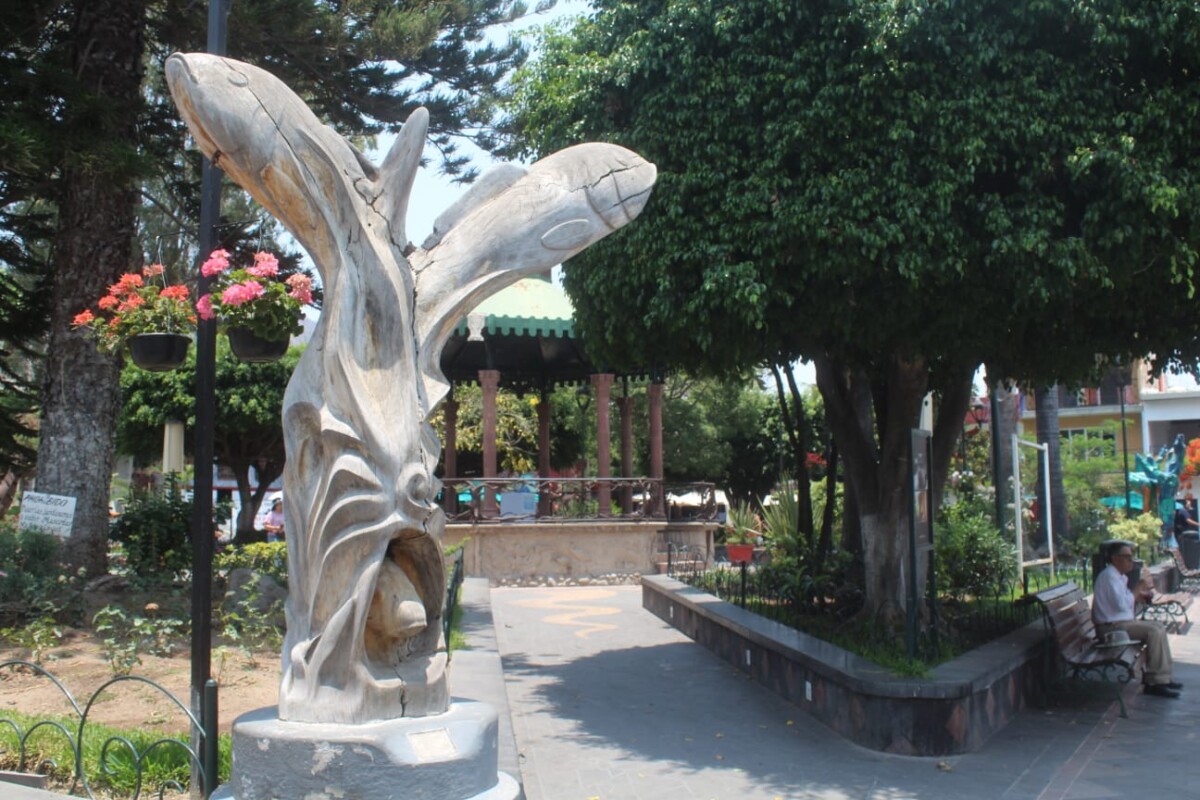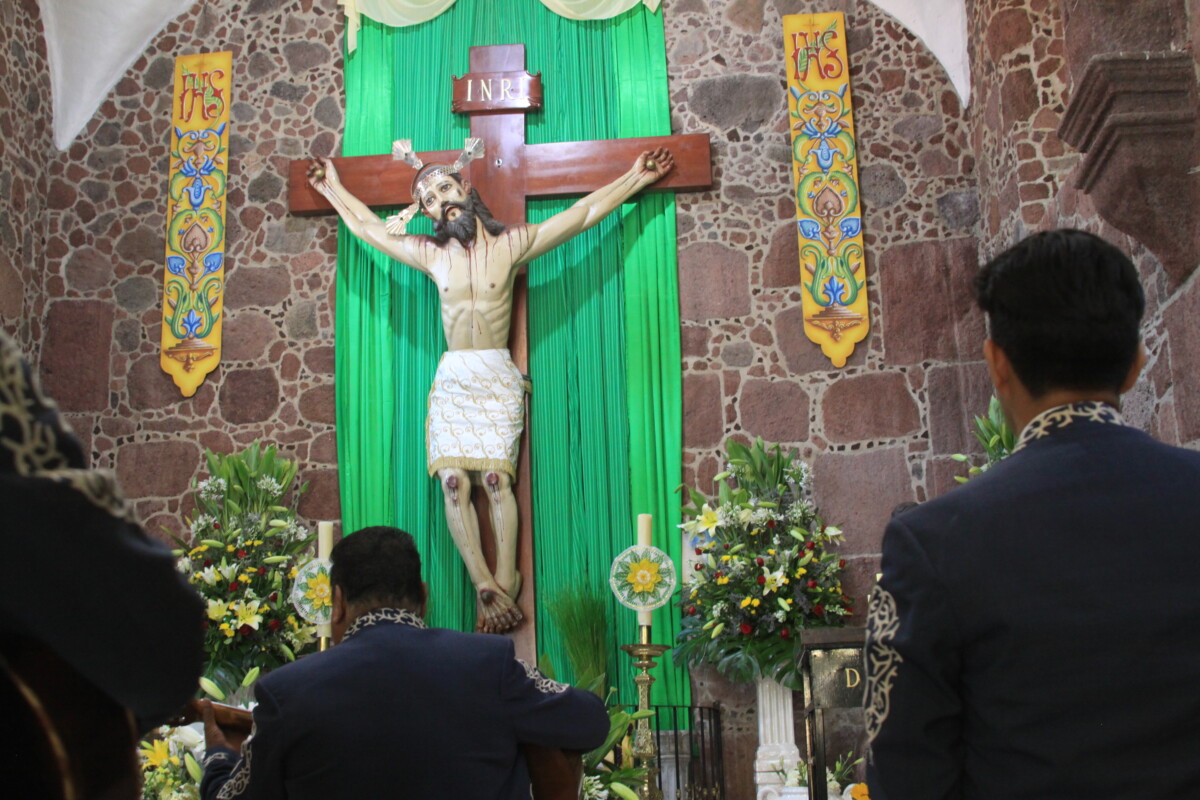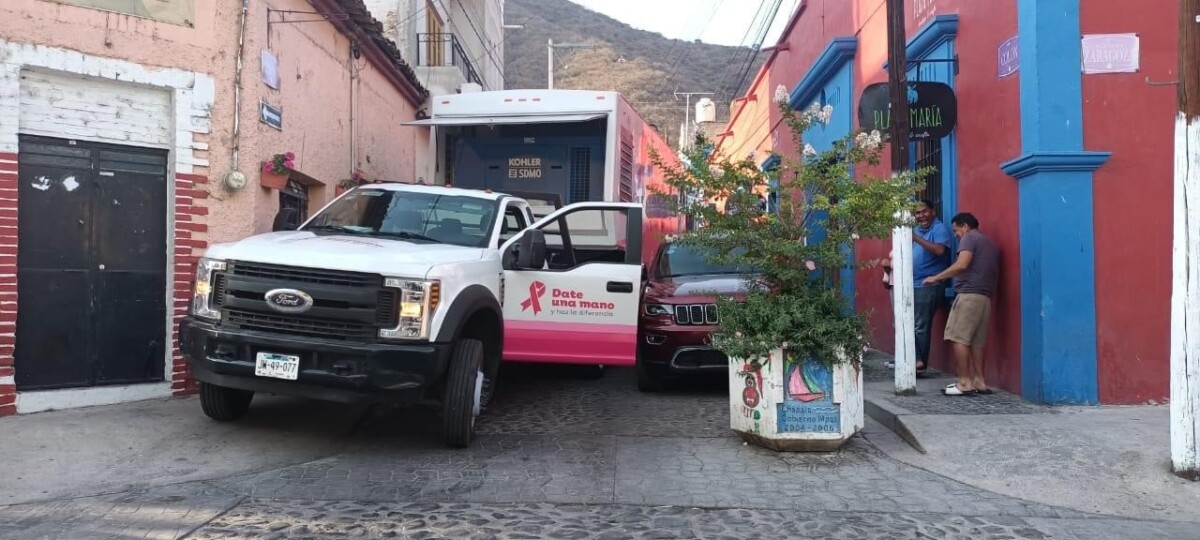municipio
A conversation with Lakeside Little Theater’s new President, Brian Mattes
Brian Mattes, new President of LLT at his home in Ajijic. Photo: Patrick O’Heffernan
Recently elected LLT President Brian Mattes was a Washington lobbyist for the Vanguard Group where he guided legislation to benefit retirees. He has an undergraduate degree in communication and theater and an MBA. Laguna English Editor and longtime radio host Patrick O’Heffernan sat down with Mattes at his home for a conversation on the future of the Lakeside Little Theater. Below is the full interview.
The production of La MIchichuall by La Cochera Cultura i was exciting do you anticipate others like that?
The performance of Michi-Chihualli produced by El Cochera Cultural at LLT was very exciting to me and there will more like that. It was a wonderful collaboration, they were great people to work with and it was a fantastic show. Well received. Why not do more like that? And it is the direction that I want to move the theater ..doing more productions that are different from what LLT used to do. It was ground breaking on some levels, but very exciting and new and different. In the next years we will see more productions like that. We are very inclined to work with them again; we are already in conversations about that and perhaps others as well.
I know there is a bridge between La Cochera Cultural and LLT through donors to both organizations. Will you be able to form those kinds of collaborations without that kind of personal bridge?
I hope so. We would like to see some new productions like that, working within the bylaws, of course, but we can find ways to do that. So , yes. It is more a matter of the production, something that will be exciting and enlightening to the Lakeside audience. One of the visions I have is that LLT becomes a place where it reaches out to not just for entertainment, but for enlightenment, and that is where I want to go, as fast as possible.
Michi-Chiualli was produced by a Mexican organization with Mexicans on stage…is that an opening to the Mexican community or is that a very difficult challenge.
Both. It is a difficult challenge because of language issues and so forth. But I am hoping that it was a was an example of how we can overcome them and work with the Mexican community. I would love to see more Mexicans on stage…we have had the great fortune of having outstanding young Mexicans in certain roles. It was wonderful; we have had outstanding talent come from young Mexicans who filled critical roles. And it very rewarding to see the Mexican families come out and see their children on stage…and they are so happy to see their child on stage in a great production.. That is what it is all about, being happy at seeing a production. And the tradition of families in the Mexican community is paramount. So if a Mexican is on stage, the family will come out. Maybe it will lead to having other Mexicans on stage filling key roles and the families seeing another show.
Do you envision seeing Spanish or bilingual productions on stage?
I never thought about but it could be a good idea. I should explore it more. I am looking for ways to bring more Mexicans into the theater…I have not totally sorted that out yet, but I want to work toward it. May something like the Met’s projected translations project on the stage or on the back of the screen . Maybe if we could find a technical way to do that we could. That would be cool.
Would travelling troupes, Mexican or English be possible at LLT?
I am just exploring the idea of traveling troupes at LLT because there are times when the theater is dark and I am not happy when it is dark. I would like to see more shows in production. If it can filled by a travelling show and it would be giving more to the community.
Could you fill the theater with the local community – Mexicans – when the snow birds go home? Is this possible?
It is . I am exploring reaching out to the local community . It would give us something to with the theater during the summer.
You have so many ideas about theater. Are you a theater person?
I am theater Buff. I have been going to theater for about 50 years. I have seen theater around the world. I have seen professional theater in Broadway, Los Angeles, London. I have seen community theater in little towns in Pennsylvania and elsewhere. I just love theater.
I have an undergraduate degree in communications in theater and an MBA. I bring the artistic side and the business side. I think it is a unique combination to say, I can look at the artistic side but also the business side. We have to be creative, but we have to watch the budget. We have to run the theater as somewhat of a business, but not entirely. There is a great book on management written back in the 90’s called “Good to Great”. The author was challenged if the business metrics can be applied to community theater After researching it, he said that instead of the language of business, which would be naïve, we should apply the language of greatness.
I loved that and explained that to the Board.
My goal is greatness. We will let the patrons define greatness. If we do great shows we will have great audiences, and we will raise more money and produce more great shows, and it will get going like a flywheel.
Greatness can mean changing the culture – a new way of doing things. LLT has been trampled by a herd of sacred cows and my job is to turn them into hamburger. We are culling the herd, one by one, out they go. Do not tell me that that’s the way we have always done it. – that is like waving a red flag in front of a bull.
I want to do new things new ways – traveling troupes, collaborations, doing more with the theater in the summer- lots of things to consider..
But, we need more depth in things like directors, stage managers, etc. ,So I am starting the LLT Academy. We have already assembled a number of people who have graduate degrees in theater from here or London or elsewhere, who have done major productions. They can teach Acting 101 or 201 or 401 and courses in stage management, character development, etc. And we will develop a course catalogue for 6 -8 months. I hope to start this in September or October. I hope to have courses running by the end of the year.
I have people on the Board who are excited about this. I have reached out to theater luminaries in the area to teach; some will volunteer, some who will want remuneration. Many are eager to teach. We just have to find a facility to hold it and fit it into our schedule. I want to have them running by the end of the year for people who have an interest in theater but need to learn some skills. This will increase our depth and lead to more greatness.
But this means we need more volunteers. We will get involved in volunteer fairs. I am hoping to have a big volunteer fair, open house at LLT, maybe in September, where people can come and tourn the theater, meet people behind the curtain, meet directors, stage managers, other actors, see the course catalogue an volunteer right there at the theater.
Would the academy be an opportunity to train people for the long term?
That would be my fondest dream. Start someone young in the Academy , taking courses for a year or two or three, then get them involved as an understudy or apprentice who would develop over the years. Then the next thing you know comes Season 60 and we have this huge number of seasoned people who can put on even better shows. I am looking past my term to season 60 and 64 to lay the groundwork for greatness after my term.
And we need to develop backstops…someone to step in when we lose a sound board operator or director, or whatever. We will do this in my first term. We can’t run the risk of not running a show because someone did not wake up, or was incapacitated. We are not running the theater with 30 somethings. We have to consider this; at the retreat with the Board I said we have to have a succession plan in place for all key positions We identify people and train them if we have to.
Demographic changes are happening – younger people are moving here. Is LLT tracking this and its possible impact on programming?
Yes. We are actually tracking a lot of changes in the audience, We have noticed there is a high intellectual capacity in the Lakeside community. There are many people with college degrees, advanced degrees and they are looking for something more novel more enlightening than a fluffy comedy, but something more engaging. This is true for the young families and the cyber nomads. They want something more intellectually challenging.
I have a new board member, Mark Nichols with a fantastic career at the Schubert organization in the US, and I am just tickled that we have him on board. He will bring this kind of analysis to the board of who is our audience and what are they looking for. At the end of the day the we exist to enlighten and entertain our patrons, and that is what we need to give them….I think we need to do an even better job…we are looking at who is our audience, what are they looking for , and give it to them.
Was “Silent Sky” an example that kind of intellectual challenge?
Absolutely! I loved it and the audience loved it…it was so novel, so different. I was stage manager during several performances, so I could talk to audience members coming out at the end of the show. They were thrilled. When you walked into the theater there was this music playing, there was an engaging set that was different, not a bunch of flats that looked like someone’s dining room. …it was mind-expanding. I was so excited by that kind of play , I can’t wait to do more like that.
Is there any risk that you will be too innovative for the existing audience, that they will say this is not the old LLT I am use to?
I hope they say that! I was asked to run for President to not to be a caretaken and I won’t be a caretaker. I will quit first. I want people to say “Wow that is different LLT and I like it”. I don’t want a status quo, doing what we are used to doing. I want to shake things up I want to make LLT a place to go not just for entertainment, but for enlightenment. That is the mark of a great theater. New Things, new ways despite the sacred cows and all that. I understand there exists a magic tome called the LLT Rulebook. If I ever find it, I will have a bonfire on the Angel Terrace to burn it.
We will still have a varied collection of plays each year – a comedy, a music.al, etc. But great plays.
Going back to “Silent Sky” that was such an audience hit, and so was Random World and so was Madre. When people saw Madre, every night, they were in tears, and it was wonderful. That is what I want. We moved the audience with those plays. There was connection. We created something that excited them. I want people to say that is not the old LLT and I love it.
I know there is some risk involved. When radio stations change forms, they lose some of the old audience. But they gain a newer , bigger audience. Cadillac went through a major change because its buyers were old and dying off, They needed to attract new buyers. So they did and sales are up. We have to go through the same thing….change.
Change management is difficult , and some people will be upset. But at the end of the day you have a great product to offer if it is done right. It has to be great, it has to be something they like. They may have liked LLT in the past, but wait until they see what is coming.
And not just the Main stage, maybe travelling troupes, maybe concerts, maybe something else. Look at the staged readings…people loved them. The 10 minute plays are great idea . MT Live has become a big success. I have become acquainted with something called Alice’s Parlor , which has run in 30 theaters in the US, in which of plays with a similar themes are presented over different nights,s o you can see a variations of the play on successive nights. Other things we have not seen at LLT before include summer stock. We can create more reasons to come to LLT and that is very exciting.
Holiday visitors fuel an economic boost for Jocotepec
Jocotepec boardwalk merchants claimed sales were slow, but official estimates of tourist revenue paint a brighter picture. Photo: Hector Ruiz.
Héctor Ruiz Mejía (Jocotepec).- After a “terrible streak” caused by two years of the Covid-19 pandemic, the recent Easter holiday season had a favorable economic impact in Jocotepec, said Víctor Loza Ornelas, director of Tourism and Craft Development for the municipality.
More than 18 million pesos (about US$900,000) were spent in the municipality during Holy Week and Easter, according to a management study of estimated tourist revenues.
The estimate was based on the average number of visitors, which, according to the director, reached 18,000 over the holiday period.
Visitors are classified into two categories: those just passing through and those staying for an extended period.
Those who visit for just one day are estimated to spend around 350 to 400 pesos per person.
Longer-term visitors, including those making use of the municipality’s hotels, are estimated to spend between 1,200 and 4,500 pesos per person.
Merchants along the Jocotepec boardwalk have complained that holiday sales were lower than anticipated.
But Loza Ornelas said he was satisfied with the results, particularly given the “terrible streak” of the past two years, caused by the pandemic.
Translated by Alan Ferguson
Chapala stands out in job recovery during April; Jocotepec in job losses
Chapala generated 76 new formal jobs during April, according to the IIEG. Photo: Archive.
In April, Chapala was placed on the list of 20 municipalities with the highest job generation, while Jocotepec joined the list of those with the greatest losses.
This is according to figures presented by the Institute of Statistical and Geographic Information of the State of Jalisco, or IIEG, based on the IMSS database of insured workers.
Chapala ranked 13th with 76 new formal jobs generated during April, 59 of them permanent and 17 temporary. Leading this category was Autlán de Navarro with 514 workers, Tonalá with 454 new jobs and Guadalajara with 401 more insured workers.
In contrast, Jocotepec ranked sixth on the list of municipalities with the greatest loss with 271 fewer formal jobs,167 casual and 104 permanent. Zacoalco de Torres had the greatest number, losing 925 workers. Tlaquepaque lost 835 and Zapotlán el Grande lost 741 formal jobs.
At the state level, Jalisco lost 2,061 formal jobs during April 2022, mainly in the agriculture, livestock, forestry and fishing sector. Despite this drop, during the first four months of the year, the state generated 34,716 new jobs, making it the second state in the country with the highest accumulated annual figure.
Translated by Mike Rogers
Lakeside Chronicles
The Christ buried among the dust of the years carried in the cendal with a paper in which was inscribed «El Señor de la Esperanza» (The Lord of Hope).
The bloody arm and half of the face was the only thing that could be seen of the crucified figure. He was buried in the middle of the old floorless cellar in the temple of San Cristobal Zapotitlán. A mound of ant dirt and dust accumulated over the years covered the figure.
A yellowed piece of paper that fell when the cloth was removed said «Señor de la Esperanza» (Lord of Hope). The cloth was also stained and when touched it broke into pieces. The rickety cross was a pale green color; the Christ figure was complete.
Ruben Solano Gonzalez had dreamed of that Christ without knowing him. He pointed to him precisely, when he went to the temple in search of that crucified one who in his dreams was asking to be taken out of there. Ruben was sick, but his insistent words said that behind the altar was the one who asked him to come out into the light. He had looked for the sisters of the Magdalena Sofia house, he had told his father; it was the sacristan Genaro Reyes Gallardo who took him to him.
-That’s him,» he told him.
A few months later, Ruben died.
-If you want to leave, no one will say anything,» said Genaro to the Christ who was waiting under that sheet of dust, while with the help of a couple of children he undertook the rescue.
Then he placed him in the baptistery; when the nuns saw him, they only asked where the Christ had come from. The priest also gave his approval. That was about 40 years ago.
Genaro became very fond of him, and received miracles from the Christ. Even when he retired for a while from his work in the church, he thought of him with religious fervor.

The faithful accompanied the procession with prayers and chants, accompanied by a mariachi.
Upon his return to the village, Genaro found that the priest on duty had baptized him as «Dulce nombre de Jesús» (Sweet name of Jesus). And having performed a miracle on him, the parish priest organized a triduum, 3-days of prayer to honor him. Over the years, the triduum became a novena (a 9-day prayer celebration), and every second Sunday of May the bells tolled in his honor and a mass was celebrated.
In 2022, almost four decades after that discovery, the Señor de la Esperanza receives the honors and fervor of the parishioners, although with a different name.
At 5:00am the first rocket in his honor goes off. The faithful, mostly women, make their way through the cobblestone streets, some carrying a candle. The musicians of the town begin to arrive at the meeting point, today it is to the east.
One of the women in charge of the day walks in front of the procession carrying a one meter high Christ. There are only 25 of us walking towards the temple accompanied by the music.
When they arrive at the church, they are greeted by the ringing of bells and another barrage of rockets.
The Señor de la Esperanza is now dressed in a brown cloth with the chalice and the Holy Shroud in the center, in the middle of a light blue; two days of hard work took the Jocotepec worker, Don Pedro Mendoza Navarro, to weave each thread of wool to give the crucified the premiere on his day.

One of the streets decorated with colored sawdust.
The voice of a woman stands out and others second her in the final chant, which with difficulty reaches the end because several can be heard coughing; the last minutes are a concert of coughs, which are compensated by the hot cinnamon and the pieces of bread offered at the end by those in charge of the day.
For the procession, the Señor de la Esperanza is adorned with a blaze of golden rays and placed on the platform of a pickup truck. At his side is again Genaro Reyes, who has decorated the mobile altar with white and yellow chrysanthemums for its travels through the main streets of the town, leaving faces dazzled with fervor.
Today he is accompanied by the faithful armed with their flowered and multicolored parasols, as well as with mariachi, the band, and the dancers who honor him.
Upon arrival, the eyes of the faithful are absorbed in the battered face of Christ, the countenance of a woman who is in front seems to be transfigured and the crucified seems not to want to enter when a group of about five men with difficulty enter the temple with the statue on their backs.
-Long live the sweet name of Jesus! shouts a woman’s voice.
-Long live the Lord of Hope! shouts another.
-I think he wanted to get out, because I was able to do it with the help of two children. And now they can’t,» says Genaro.
It is said that many priests who have visited the parish have been very struck by his face, by its realistic deathly appearance; by the deep pain in its half-open eyes and the drama of its fainting body.
They say that according to a restorer who came to see it, the figure was carved by hand in hollow wood, that its fleshy side is covered by a fine paint and the teeth that can be seen through its half-open lips are made of ivory.
Now it is before the eyes of all that Christ who waited for who knows how many years in oblivion, carrying his name girded on the cloth, waiting perhaps for the voices invoking his name.
“Long live the Lord of Hope!”
Translated by Kerry Watson
Ajijic lacks a project to access resources for Pueblos Mágicos
Main square of the Magical Town of Ajijic. Photo: Sofía Medeles.
Sofía Medeles (Ajijic).- Despite the publication of the guidelines of the Program for Support and Promotion of Magical Towns of the State of Jalisco, the Chapala government has failed to make progress in any of the projects required to access the available funds.
Social communication Director Elizabeth Oropeza Silva informed the media that they have not yet entered the grant program nor have any proposal ready to gol; however, next week they will have a meeting with the Secretary of Tourism of Jalisco, Claudia Vanessa Pérez Lamas.
The work will taken over by the municipal commission set up by Ajijic councilwoman Denisse Michelle Ibarra González, municipal trustee Gamaliel de Jesús Soto Pérez, and councilman Francisco Iván Gutiérrez Pérez.
The Program for Support and Promotion of Magical Towns of the State of Jalisco was published on May 3, 2022, in the Official Gazette of the State of Jalisco and stipulates the areas of strengthening announced by the governor. These are: understanding and improvement of traffic patterns and mobility, creation of the position of tourist agent and establishing the office, and improvement of the urban image and waste management.
The required projects will have to focus on these elements to access Ajijic’s share of the 17 million pesos which are divided among the nine Magical Towns. The overall budget allocates 3.5 million to mobility research and projects, urban image and waste management research and improvement; 3 million to set up and staff the tourist agent office; 9 million 790 thousand pesos for the improvement of the urban image; and 210 thousand 100 pesos for the administrative costs of remaining in the program.
The review and subsequent approval of the projects will be managed by the Evaluation Committee of the Ministry of Tourism of the State of Jalisco, and the support may be given in cash or in kind.
Translated by Patrick O’Heffernan
Alfaro rules out construction of second Chapala-Guadalajara aqueduct
View of Lake Chapala from the shore of the beach next to the Ajijic dock. Photo: Archive.
Editorial Staff. Jalisco Governor Enrique Alfaro Ramírez ruled out the construction of a second aqueduct to supply the Guadalajara Metropolitan Area (AMG) during his term of office.
«This was my campaign commitment and I stand by it. We are not going to take one more liter from Chapala. We cannot drain the lake to solve the city’s supply problem. That commitment continues. We are not going to build a new aqueduct, but we are going to continue with the maintenance works of the old system,» said the state president.
He made this statement after academics from the Universidad de Panamericana (UP) urged state authorities to inquire about the need to build a new aqueduct to draw water from Lake Chapala.
The governor of Jalisco dismissed this observation by declaring that no more water can be taken from Mexico’s largest lake. The specialist in water technologies, Daniel Sánchez Tapetillo, replied that the second aqueduct would have the function of substituting for the first one in case it failed.
«The second aqueduct is not to take more water from the lake than the Guadalajara Metropolitan Area already has a concession for. To believe that is a mistake. We have a concession of 236.5 million cubic meters a year, that is, 7.5 cubic meters per second. The two aqueducts could never operate simultaneously.»
The specialist assured that, after 30 years of age, the maintenance of the first aqueduct is urgent, because in the event of a failure, 60 percent of the water needed would no longer be supplied. In his opinion the useful life of the current system has already been exceeded.
Sanchez Tapetillo said he regretted that the governor did not listen to the proposals of academics from the University of Guadalajara (UdeG), the Pan-American University (UP) or the Technological Institute of Superior Studies of the West (ITESO), since they are institutions that for years have reviewed the issue and their contributions are to act in time and prevent more than 60 percent of citizens of Guadalajara from running out of water.
Translated by Nita Rudy
New SIMAPA administrator appointed in San Nicolás de Ibarra
Juan Antonio Vázquez Ayala is the new water administrator in San Nicolás de Ibarra.
Jazmín Stengel (Chapala).- The petitions have been heard. Juan Antonio Vázquez Ayala was appointed as the new administrator of the Municipal Water and Sewage System (SIMAPA) in the delegation of San Nicolás de Ibarra, Chapala, at the insistence of the inhabitants.
During the meeting held on April 25 with the municipal president Alejandro de Jesús Aguirre Curiel and a committee of officials, the inhabitants of the town requested the replacement of Santiago García as administrator of SIMAPA and of the spokesperson Ricardo Razo, due to alleged mismanagement of the water and its wells, as well as the making of decisions without consulting the people.
Although the petition issued during the meeting by the villagers wanted Luis Morales Contreras and Irma Reyes Delgado included as part of SIMAPA’s municipal council, other people received the appointments.
Vázquez Ayala was appointed as the new water administrator in San Nicolás de Ibarra and will oversee the documentation, organization, procedures, complaints and recommendations that the population has before SIMAPA. In other words, he will act as an intermediary between the demands of the delegation and the central offices of the municipality.
The appointment of the new spokesperson, who will represent the population in the SIMAPA Council, has not yet been approved. However, the neighborhood committee will decide the new person in charge through a general meeting with the people, stated Vazquez Ayala, who took the opportunity to thank the mayor for his participation and the people for giving him their trust.
Translated by Sandy Britton
Siembran 150 mil crías de tilapia en el Lago de Chapala
Alevines de tilapia en una bolsa de plástico antes de ser liberados. Foto: Archivo.
Redacción. – Como parte del compromiso de la Centro Acuícola Tizapán, integran la primera entrega de parte de la Secretaría de Agricultura y Desarrollo Rural (SADER) Jalisco de donar 500 mil crías de peces para reactivar la actividad pesquera en el lago de Chapala, se entregó el primer lote con 150 mil unidades de tilapia en el Malecón de Jamay.
Durante el evento, la titular de SADER Jalisco, Ana Lucía Camacho Sevilla, observó que esta entrega proviene del Centro Acuícola Tizapán y surge a raíz de la preocupación de los pescadores de Jamay por la disminución en la captura de tilapia, de la cual depende su actividad productiva: “Es la primera parte del compromiso que hicimos”.
Luego de recordar que la Asamblea General de las Naciones Unidas declaró 2022 como el Año de la Pesca y la Acuicultura Artesanales, reconoció el trabajo de quienes se dedican a este oficio. “Por eso vamos a seguir reforzando su labor con crías de peces y con equipamiento para que realicen sus actividades de manera más oportuna”.
El presidente municipal de Jamay, César Celestino Molina Sahagún, comentó que esta entrega es la respuesta de un compromiso de la secretaria, Ana Lucía Camacho Sevilla: “Ella escuchó las necesidades de los pescadores y poco después la tenemos aquí. Esto se agradece y se le reconoce”, no sin recalcar la importancia de fortalecer al sector con el repoblamiento de peces y equipamiento.
María Refugio Hernández, en representación de las cooperativas pesqueras y fileteadoras, agradeció a las autoridades por el apoyo. “Será un impacto fuerte para nosotros. Hasta ahora, con esta administración del Gobierno Estatal, vemos resultados. Estos proyectos serán un bien para todos y mejorará el ingreso para nuestras familias”.
Para saber:
Jamay y Poncitlán son los municipios que cuentan con más organizaciones pesqueras, con 15 cada uno. Chapala y Ocotlán tienen ocho cooperativas, Tizapán seis, Tuxcueca cinco y Jocotepec tiene cuatro agrupaciones de pescadores.
Fuente: https://www.jalisco.gob.mx/es/prensa/noticias/143406
Lakeside Chronicles
The traditional Las Mañanitas are sung by the mariachi in the festival of the Lord of Huaje.
By: María del Refugio Reynozo Medina
NOTE. Just as Mexican Catholics recognize many representations of “la Virgen,” they also recognize many representations of Jesus Christ. Usually these are depicted with a sculpted figure, sometimes of great antiquity and value, often dating back to the 1500s or 1600s when Spain was establishing the church here. These representations have their own names and their own celebration days, and are often credited with performing miracles on behalf of the faithful. This article refers to the celebration for “el Señor del Huaje,” a large figure of the crucified Christ made of the wood of the “huaje” or tamarind tree, which is celebrated with a festival and procession on the first Sunday in May each year.
The streets of Jocotepec are still in darkness. It is about 5:30 in the morning and the orange flowers and green foliage of the flame-red tabachine trees at the entrance of the temple look grayish.
About a hundred people are already gathered inside and outside the temple, under the leafy trees. Dances are being prepared and the brass band is playing. Steaming pots rest in their stands. Chocolate, cinnamon and tamarind atole (a hot cornflour drink) awaits the faithful who gather at the temple of the Señor del Huaje, for his feast.
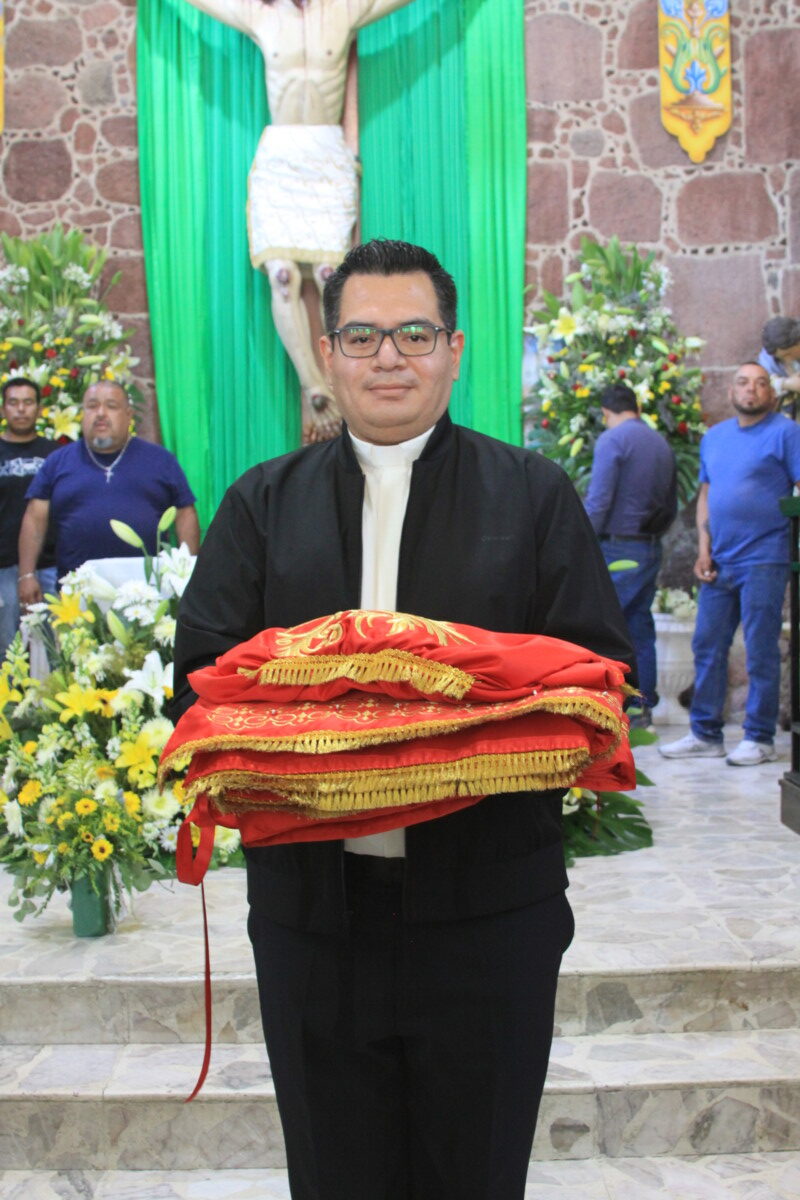
Father Eduardo Garcia Orta with the new cendal or loincloth that was presented for the festival of the Lord of the Huaje. In the words of Father Lalo, the fiery red symbolizes the spilled blood embroidered with golden threads as a symbol of royalty.
The band is playing a popular dancing song, El Mono de Alambre (The Wire Monkey). The men of the band sing. The bells ring the second call for the six o’clock mass and Father Mario Fernando Sandoval Varela comes out of the temple to welcome the cargueros (the men who will be carrying the figure of the Señor del Huaje in the procession).
“How about the music,» he says. And El Mono de Alambre is interrupted by the chants of a procession.
“Long live my Christ, long live my King,” some women sing, and the band stops.
Soon the San Cristobal Band arrives and intones the traditional Las Mañanitas, followed by waltzes and pasodobles dances, which permeate the Eucharistic celebration.
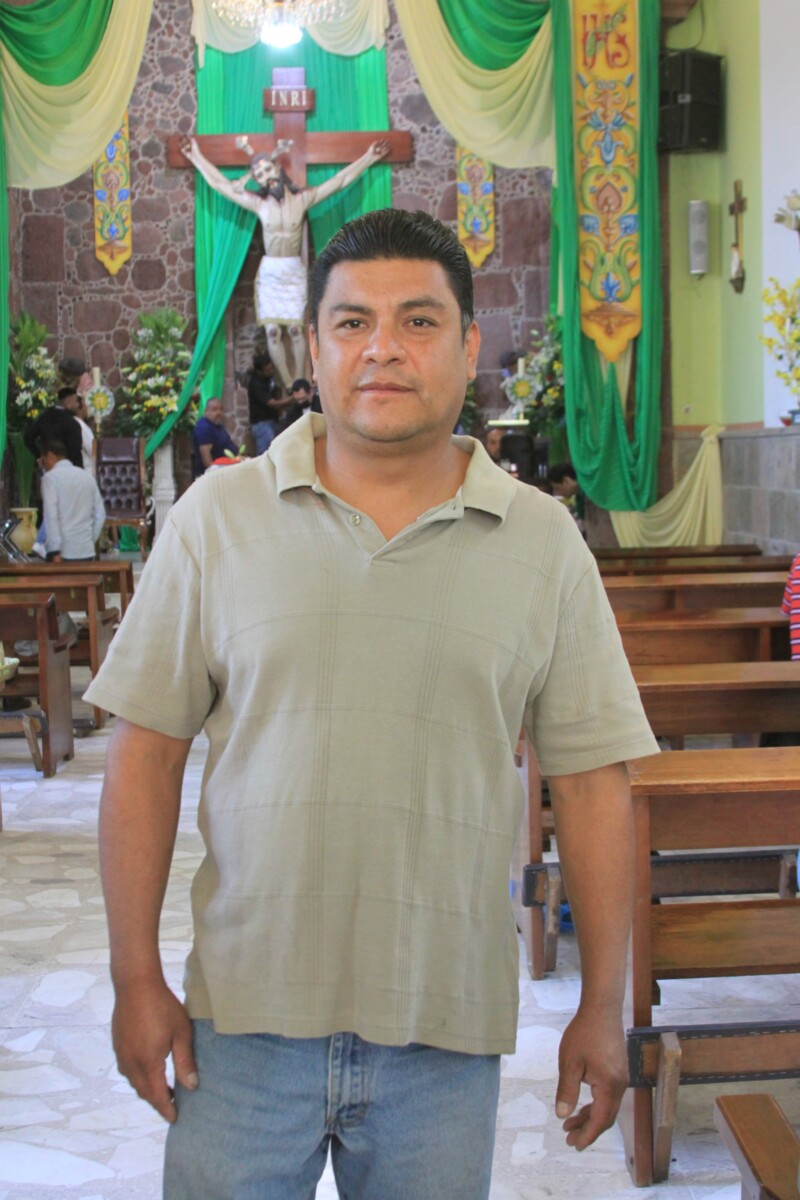
Carlos Mendo has been responsible for the honor guard of the Lord of Huaje for ten years.
At the end of the mass, a man reads a list of the various expenses of the festival: the music, the dawn ceremony, decorated candles, dances, dinner for the musicians and the castillo or fireworks tower. He names the families who will assume the expenses. Many of them are from the Nextipac neighborhood
At the exit of mass, they begin to distribute the drinks and the dancers execute their movements to the sound of the drum and the caracol, a prehispanic musical instrument like a trumpet made of shell or ceramic.
Today is expected the visit of Father Eduardo Garcia Orta who spent three years in the community of Jocotepec and still retains the affection for these lands and the veneration for the Lord of the Huaje.
Father «Lalo» as the community calls him, is on his way with a very valuable cendal, a beautifully decorated loincloth that will be wrapped around the image of Christ to be premiered by the Señor del Huaje in his feast. Some representatives of the honor guard gather and wait eagerly for its arrival. «They say that this loincloth has golden threads» a discreet and festive voice is heard. There is much excitement to see it and to welcome the priest.
Upon his arrival, Father Lalo is received with signs of affection. They congregate at the altar and everyone approaches to see the loincloth, which is bright red with gold embroidery.
To carry out the change of the loincloth, putting the new one in place of the current one, the men remain in the enclosure and the women wait outside. A woman who accompanies me in the wait says, “These are men’s duties; women have no business being there.”
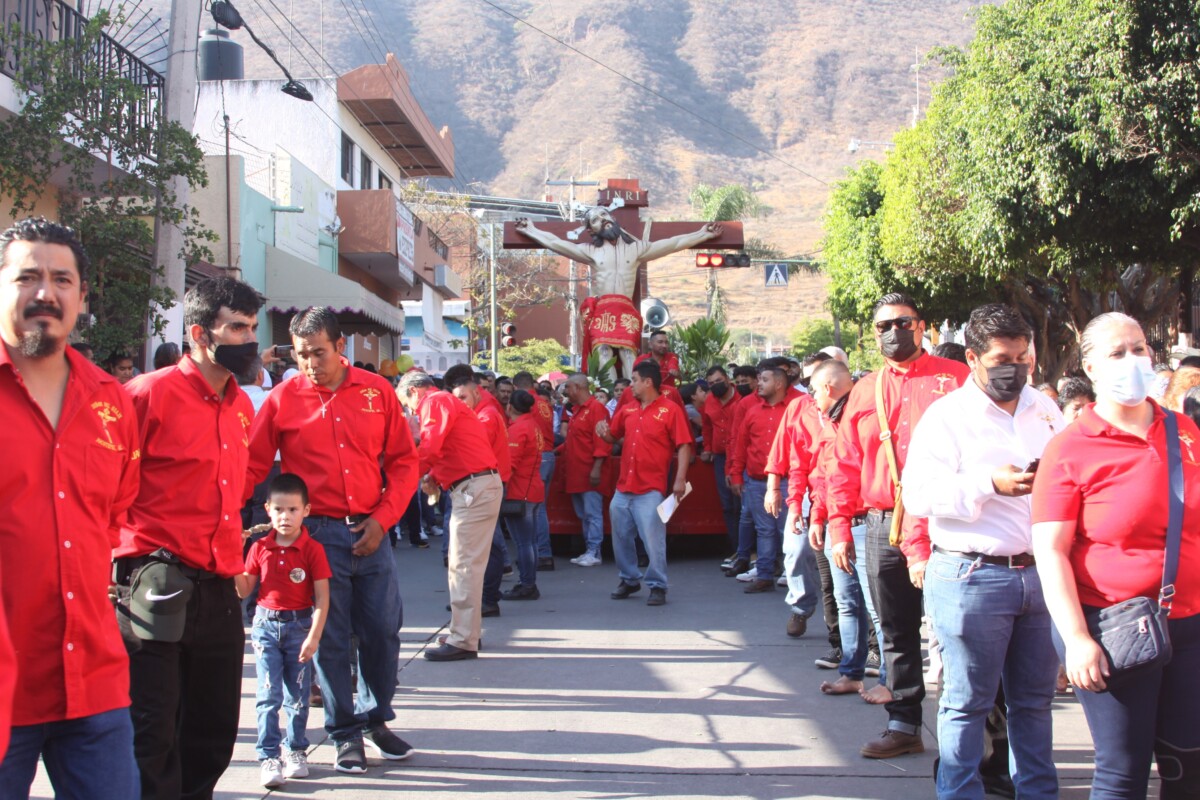
The members of the guard of honor wear bright red shirts to guard the Lord of the Huaje.
Carlos Mendo is the main person in charge. For ten years, he has overseen the honor guard. It is made up of about a hundred people, mostly men and a few recently integrated women. He was questioned by some parishioners for having allowed access to women.
“God doesn’t say you don’t or you do,» he responded confidently.
Mr. Roberto Mendo, Carlos’s father, was the last person in charge and left the position to his son.
It is a great responsibility, says Carlos, because it means taking care not only of the image of a beloved Christ, but also of a piece of historical artistic value. The last restoration cost 140,000 pesos (about US$7,000), which were raised with donations from the community.
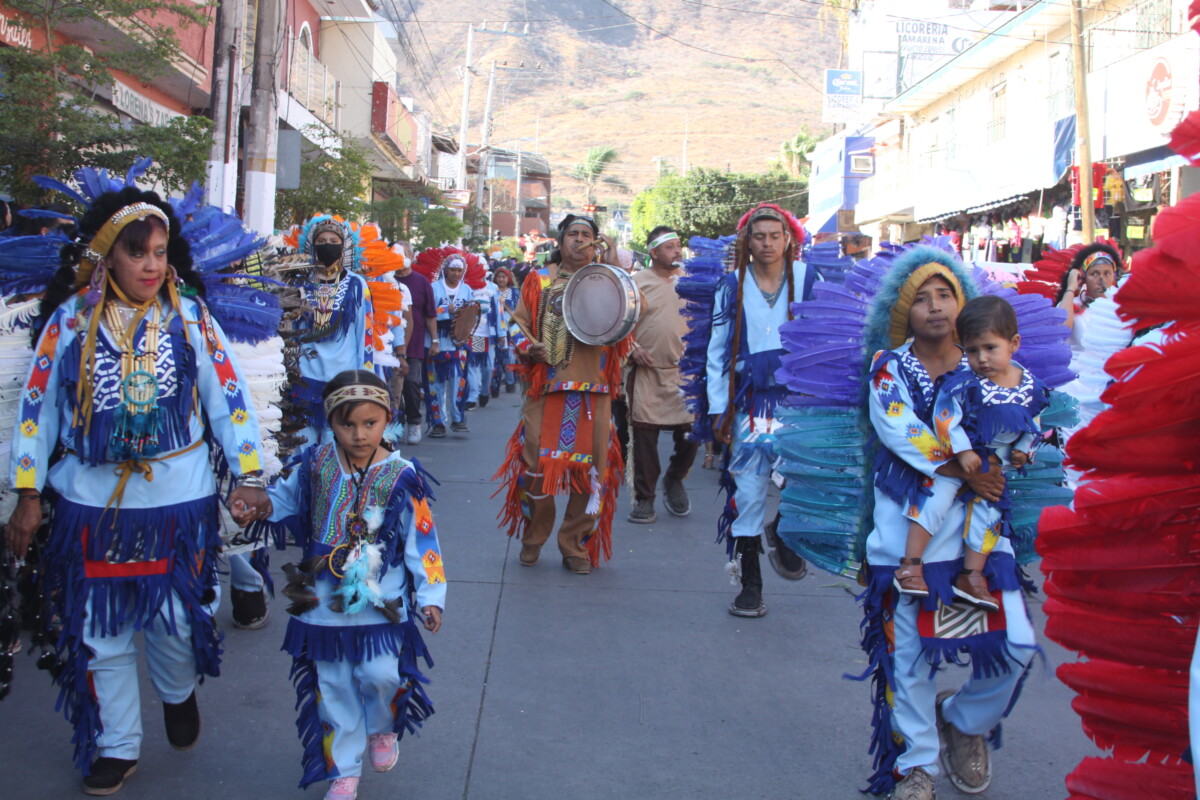
The dances are present in the procession in which children and adults participate.
It is a difficult responsibility, but it is also a blessing. «Now I only ask for work and health,” he said.
Víctor, a member of the honor guard, shares a testimony. His wife was sick for a couple of months, having inexplicably lost the mobility of her body, during which time she remained in bed in a lot of pain. They went to several doctors and his wife’s health did not improve. One morning, she told him, “I dreamed of the Lord of the Huaje.”
In the dream, the Lord of the Huaje told her to «drink from that water,» pointing to a small puddle next to him. The woman asked to be taken to the temple with the figure of the crucified Christ. When she was in front of the altar there was some water on the floor, so she brought her lips close and implored for her health.
That day she walked out of the temple, healthy. From then on, both asked to be part of the honor guard.
On the first Sunday of May, the day denoted for this celebration, the procession is almost the last ceremony of the day. Before that, mariachi musicians coincide with the band with their blue shirts and at least five groups of dancers. Colorful plumage abounds to the beat of the drum.

Many parishioners go to meet the icon on their knees.
There are lines of people kneeling to approach the crucified figure to fulfill a request or ask for a favor.
The route of a couple of hours is a mosaic of dancers with multicolored feathers and costumes, musicians with their polished costumes and the honor guard with their bright red shirts.
The sound of the drums announces the approach of the procession. As it passes, the figure of the crucified Christ, almost three meters high, draws sighs and tears.
In a loudspeaker, the voice of a woman prays and sings, “There are eyes that, if they look at me, make my soul tremble with love, they are such beautiful eyes…”
The Lord of the Huaje is carried on a special platform driven by a man. He advances, standing out among the crowd with his gaze towards the sky, towards the mountains, towards the faithful who sometimes look into his eyes. “Because He lives,” says a woman next to me, ecstatic with fervor.
Translated by Sandy Britton
Mammogram truck gets stuck entering Ajijic
A planter had to be moved with a crane to allow the truck to pass.
After unsuccessful maneuvering attempts and wanting to move the other truck, the operators decided to call a crane to move a planter so that the pickup, whose owner was not present, could be moved and the mammogram unit could get out of the situation.
Translated by Paul Weeks
© 2016. Todos los derechos reservados. Semanario de la Ribera de Chapala

